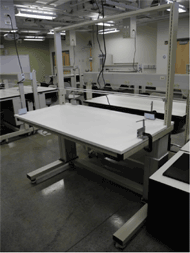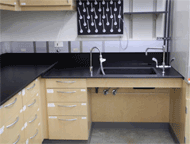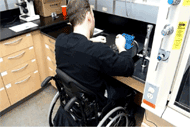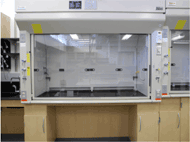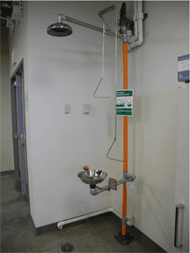Designing Beyond the ADA - Creating an Accessible Research Laboratory for Students and Scientists with Physical Disabilities
Lisa Hilliard1, Phillip Dunston2, James McGlothlin3, Bradley S. Duerstock1
Institute for Accessible Science (IAS), Weldon School of Biomedical Engineering, School of Industrial Engineering, Purdue University1
School of Civil Engineering, Purdue University2
College of Health and Human Sciences, Purdue University3
INTRODUCTION
Active “hands-on” laboratory experiences in a classroom or research setting are critical to the development and success of professional scientists (National Research Council, 1996, Stefanich, 2007). Unfortunately, these opportunities are often few or nonexistent for persons with disabilities (PwD) interested in pursuing a career in science, technology, engineering and mathematics (STEM). This is even more evident in recent years as laboratory science disciplines experience a thrust for diversification through the inclusion of persons with disabilities. With a pool of around 3 million high school graduates with disabilities to tap, why does research suggest only .01% of this population receive PhDs (Lunsford & Bargerhuff, 2006 and Supalo, Mallouk, Amorosi, Lanouette, Wohlers & McEnnis, 2009). A critical component and priority in fostering this laboratory based discipline and career inclusion must be to develop strategies to break down the physical and attitudinal barriers that PwD face in pursuit of these career goals (Lunsford & Bargerhuff, 2006).
The underrepresentation of PwD in STEM disciplines is often linked to perceived difficulty in providing these students with an interactive, independent experience, diminished expectations and limited opportunities for exposure both in and out of the classroom (Dunn, Rabren, Taylor, & Dotson, 2012 and Supalo, Mallouk, Amorosi, Lanouette, Wohlers & McEnnis, 2009). Often when interviewed, undergraduates with disabilities indicate their choice to not pursue a laboratory based career is the perceived inaccessibility and “hands-on” training requirements of these careers not a lack of interest (Duerstock, 2006; Mansoor et al., 2010). Furthermore, literature searches reveal a very limited pool of best practices or documented resources for a college mentor, instructor or student to source when formulating a learning pedagogy with accessibility in mind (Boyd-Kimball, 2012). The considerable number of physical obstacles feeding this brain drain of problem solving talent from STEM higher education and ultimately careers is also a contributing factor.
Laboratory infrastructure is all too often unwelcoming even inaccessible to persons with physical disabilities. It is a visually obstructive environment often navigated by narrow, blind paths, encumbered by high workbenches and overcrowded fragile equipment. This changing landscape requires the critical assessment of the physical accessibility of standard laboratory design. In order to support independence and foster inclusion, the first priority is to ensure a convivial, safe environment with practical assistive solutions delivered in an easy, accessible ergo friendly laboratory design.
METHODS
Accessible Biomedical Immersion Laboratory (ABIL)
Using a combination of the guidelines set forth by the Americans with Disabilities Act (ADA) for building standards, those governing safety equipment installation prepared by the International Safety Equipment Association (ISEA) and approved by the American National Standards Institute (ANSI) and literature review (BlakeDrucker, 2009; Smyser, 2003), the IAS began accessible renovations of an e xisting ‘wet’ laboratory space in Purdue University’s Discovery Park in 2011. This unique educational space located at the Discovery Learning Research Center (DLRC) was constructed to facilitate interdisciplinary scientific projects and research in a learning laboratory environment. In addition, to ensure these governing guidelines were adequate and encompassing a neuroscientist who uses a power wheel chair due to quadriplegia assessed and provided input throughout the renovation process.
 Figure 1. ABIL Laboratory Work Triangle
Figure 1. ABIL Laboratory Work TriangleABIL modifications were centered on the typical architectural features required to perform ‘wet’ laboratory research. The laboratory work bench, sink and fume hood were identified as three main areas where hands-on scientific research often occurs. The concept of this accessible “lab work triangle” (Fig 1) is based on the established ergonomic principles behind the kitchen and other workplaces (Gilbreth, 2013) . In addition, laboratory safety is a critical component of scientific research, yet its accommodation for persons with physical disabilities can be overlooked. In ABIL, several modifications were made to allow persons with physical impairments to more easily access standard laboratory and safety equipment.
RESULTS
The goal of our accessible laboratory work triangle, composed of the laboratory bench, sink and fume hood, was to orient these commonly used work areas at close enough proximity to enhance efficiency yet provide enough clearance to promote comfort and ease of maneuverability (Fig 2).
Throughout the renovation process, we found building standards and safety installation guidelines only broadly prescriptive; focusing solely on heights from the floor, spray diameters and general operability features. Our motorized wheelchair user was unable to gain access to the eyewash basin and showerhead as prescribed due to an inability to position themselves centrally beneath the dispensing devices resulting from a lack of depth from the supply line. In addition, the standard emergency shower and eyewash specifications made no reference to pull/value placement for users of various body types. The standard positioning height of the safety shower pull from the floor makes it inaccessible to lab users of limited stature or those in a wheel chair in case of an emergency.
The Lab Workbench
The first component of the laboratory work triangle, the lab bench is where most experiments are performed. In ABIL, we have replaced a traditional stationary lab bench with a power-adjustable-height lab bench (Fig 3). Through simple push-button operation, the height of this bench can be lowered to accommodate low stature or seated researchers or raised for those who stand. Located on or near the power-adjustable lab bench are several pieces of accessible equipment for performing common lab tasks more independently . These include a talking scale for low vision users and a motion-activated biohazard disposal container for persons with mobility impairments. In addition, an automated, touchless paper towel dispenser manufactured by Smart Product Innovations, Inc. known as the CLEANCut was acquired. By simply breaking laser sensors with an object as small as a pen or big as a fist, the paper towel will be dispensed and then cut for the user, ensuring ease of operation for all. The utilitarian under mount design of the unit was problematic in a laboratory where under counter space is vital for access and clearance needs and upper cabinet height hinders independent operation thus a low height countertop stand was designed to house the unit. Not only did this broaden user accessibility, it rendered the unit mobile promoting versatility and user accommodation.The Sink
The second component of the laboratory work triangle, the sink, was enhanced for multi-user accessibility by lowering the height of the counter to 34 inches and with a 29-inch knee clearance (Fig 4). The drain was also installed at the rear corner of the sink and surrounded with pipe insulation for padding to provide adequate knee clearance and protection enabling the user complete access by positioning themselves within the cabinet cutout underneath (Fig 5). These design considerations also afford the user the ability to peer inside the sink. To further aid in user accessibility, the orientation of the faucet neck and handles were placed in parallel to one another near the front corners of the sink. In addition, standard faucet handles have been replaced with larger paddle-style handles that are easier to manipulate.The Fume Hood
The third component of the laboratory work triangle, the fume hood, is located just to the right of the sink (Fig 6). To increase accessibility of the fume hood, the height of the work surface was lowered and a centrally located under-counter access area added. The cross-style valve handles customary to fume hoods were replaced with larger blade-style handles, similar to those installed on the sink, were installed facilitating ease of use and independence. In addition, on/off switches were retrofitted on to the lower front face near the counter ensuring multi-user operability.
Inclusive Designed Safety Equipment
The emergency eyewash basin and showerhead were moved farther away from their supply line and support pipe allowing an individual in a wheelchair to easily gain access. In addition, the eyewash basin was raised to allow for adequate knee clearance and to bring the wash jets closer to the wheelchair user’s face thus eliminating the risk of a loss of balance inherent when a wheelchair user leans too far forward in order to gain access. The most significant modification to the safety shower was to provide for two different length shower pulls enabling a broader range of users to independently control the safety shower. The placement of the pulls was critical to ensure proper operation (Fig 7). The two pulleys needed to be accessible from a seated or standing position, but their operation could not interfere with one another nor interfere with operation of the paddle control for the eyewash. In addition, a large 3-dimensional wall sign was placed over the safety equipment and enlarged directional signs were added to the floor to ensure these safety fixtures could be easily visualized and quickly located.
DISCUSSION
In addition to enhancing lab safety and research capacity for PwD that might potentially utilize ABIL for training or research purposes, the IAS and Purdue’s Office of the University Architect invested in these modifications by providing a blueprint for others looking to retrofit or construct more accessible laboratory environment . The costs of modification are certainly a consideration and not all modification may be essential immediately. As an institution upgrades or repairs outdated fixtures and infrastructure, these accessibility upgraded should be considered. We found that in some cases, like the engineering of the dual pull armature, these modifications are straightforward and require no major structural changes to the facility. Since these safety devices are required within wet laboratory environments it is vital and ethically responsible to implement such changes not to mention progressive because you will be rising to meet the demands of tomorrow’s more diverse science workforce.
REFERENCES
Online Pamphlet: Blake-Drucker Architects (2009). Accessible Laboratory: Beyond ADA- Guidelines for Universal Access. Available at http://www.bdarch.com/access/details/images/accessible.pdf
Journal Article: Boyd-Kimball, Debra (2012). Adaptive Instructional Aids for Teaching a Blind Student in a Nonmajors College Chemistry Course. Journal of Chemical Education, 89, 1395-1399.
Journal Article: Duerstock, B.S. (2006). Accessible Microscopy Workstation for Students and Scientists with Mobility Impairments. Assistive Technology, 18, 34-45.
Journal Article: Dunn, Cari, Rabren, Karen S., Taylor, Stephanie L., & Dotson, Courtney K. (2012). Assisting Students with High-Incidence Disabilities to Pursue Careers in Science, Technology, Engineering and Mathematics,.Intervention in School and Clinic, 48, 47-54.
Journal Article: Lunsford, Suzanne K., & Bargerhuff, Mary Ellen, (2006). A Project to Make the Laboratory More Accessible to Students with Disabilities. Journal of Chemical Education, 83, 407- 409.
Journal Article: Neely, Mary Bethe (2007). Using Technology and other Assistive Strategies to Aid Students with Disabilities in Performing Chemistry Lab Tasks. Journal of Chemical Education, 84, 1697-1701.
Pamphlet: Gilbreth, L. Planned Motion in the Home. In, The Gilbreth Management Desk pamphlet. The Frank and Lillian Gilbreth Library of Management: The N-File. Purdue University Libraries. Accessed on 1/14/2013.
Book: Stefanich, G.P., ed. (2007) Ontogeny of Inclusive Science, Dubuque, IA: Kendall-Hunt.
Journal Article: Supalo, Cary A., Mallouk, Thomas E., Amorosi, Christeallia, Wohlers, H. David, & McEnnis, Kathleen (2009). Using Adaptive Tools and Techniques to Teach a Class of Students Who are Blind or Low Vision. Journal of chemical Education, 86, 587-591.
Booklet: National Research Council. (1996) In, National Science Education Standards. Washington, D.C.: National Academy Press.
ACKNOWLEDGEMENTS
This project was supported by the National Institute of Health Director's ARRA Pathfinder Award to Promote Diversity in the Scientific Workplace (1DP4GM096842-01 to B.S.D.). We are grateful to Eugene Hatke, Senior Architect, from the Office of the University Architect and Thomas Burns and the Zone 7 Team with Physical Facilities for their assistance and talent in executing these accessibility modifications.

